Crop Load Affects Yield, Fruit Size, and Return Bloom of the New Apple Cultivar Fryd© (‘Wuranda’)
Abstract
1. Introduction
2. Materials and Methods
2.1. Location, Plant Material and Soil Conditions
2.2. Crop Load and Return Bloom
2.3. Tree Growth and Yield
2.4. Fruit Quality
2.5. Weather Conditions
2.6. Data Analysis
3. Results
3.1. Yield
3.2. Fruit Mass
3.3. Fruit Growth Dynamic
3.4. Fruit Size
3.5. Fruit Quality Parameters
3.6. Return Bloom
4. Discussion
5. Conclusions
Author Contributions
Funding
Data Availability Statement
Conflicts of Interest
References
- Vujadinović Mandić, M.; Vuković Vimić, A.; Fotirić Akšić, M.; Meland, M. Climate Potential for Apple Growing in Norway—Part 2: Assessment of Suitability of Heat Conditions Under Future Climate Change. Atmosphere 2023, 14, 937. [Google Scholar] [CrossRef]
- Ličina, V.; Krogstad, T.; Fotirić Akšić, M.; Meland, M. Apple Growing in Norway—Ecologic Factors, Current Fertilization Practices and Fruit Quality: A Case Study. Horticulturae 2024, 10, 233. [Google Scholar] [CrossRef]
- Anthony, B.; Serra, S.; Musacchi, S. Optimizing Crop Load for New Apple Cultivar: “WA38”. Agronomy 2019, 9, 107. [Google Scholar] [CrossRef]
- Robinson, T.; Lopez, S. Crop load affects ‘Honeycrisp’ fruit quality more than nitrogen, potassium, or irrigation. Acta Hortic. 2012, 940, 529–537. [Google Scholar] [CrossRef]
- Schmidt, T.; Elfving, D.C.; McFerson, J.R.; Whiting, M.D. Crop Load Overwhelms Effects of Gibberellic Acid and Ethephon on Floral Initiation in Apple. HortScience 2009, 44, 1900–1906. [Google Scholar] [CrossRef]
- Kviklys, D.; Čeidaitė, A.; Lanauskas, J.; Uselis, N.; Samuolienė, G. Does the rootstock affect alternate bearing of apple tree? Acta Hortic. 2016, 1119, 49–52. [Google Scholar] [CrossRef]
- Baldassi, C.; Berim, A.; Roeder, S.; Losciale, P.; Serra, S.; Gang, D.R.; Musacchi, S. Rootstock and Crop Load Effects on ‘Honeycrisp’ Photosynthetic Performance and Carbohydrate Accumulation. Plants 2023, 12, 4035. [Google Scholar] [CrossRef]
- Robinson, T.L.; Gonzalez, L.; Cheng, L.; Ziang, Y.; Peck, G.; Arnoldussen, B.; Gomez, M.; Guerra, M.; Miranda Sazo Mario; Kahlke, C.; et al. Studies in precision crop load management of apple. Acta Hortic. 2023, 1366, 219–226. [Google Scholar] [CrossRef]
- Verma, P.; Sharma, S.; Sharma, N.C.; Chauhan, N. Review on crop load management in apple (Malus × domestica Borkh.). J. Hortic. Sci. Biotechnol. 2022, 98, 299–321. [Google Scholar] [CrossRef]
- Bound, S.A. Determination of Target Crop Loads for Maximising Fruit Quality and Return Bloom in Several Apple Cultivars. Appl. Biosci. 2023, 2, 586–606. [Google Scholar] [CrossRef]
- Sharma, S.; Verma, P.; Sharma, N.C. Crop load management in high density apple plantation. Span. J. Agric. Res. 2023, 21, e0905. [Google Scholar] [CrossRef]
- Atay, E.; Atay, A.N. Critical Crop Load Threshold in Nutrition and Biennial Bearing of Apple Trees. J. Agric. Sci. Technol. 2024, 26, 1027–1041. Available online: http://jast.modares.ac.ir/article-23-67263-en.html (accessed on 10 December 2024).
- Embree, C.G.; Myra, M.T.D.; Nichols, D.S.; Wright, A.H. Effect of blossom density and crop load on growth, fruit quality, and return bloom in Honeycrisp’ apple. HortScience 2007, 42, 1622–1625. [Google Scholar] [CrossRef]
- Serra, S.; Leisso, R.; Giordani, L.; Kalcsits, L.; Musacchi, S. Crop Load Influences Fruit Quality, Nutritional Balance, and Return Bloom in ‘Honeycrisp’ Apple. HortScience 2016, 51, 236–244. [Google Scholar] [CrossRef]
- Atay, E.; Crété, X.; Loubet, D.; Lauri, P.E. Effects of Different Crop Loads on Physiological, Yield and Fruit Quality of ‘JoyaTM’ Apple Trees: High Crop Load Decreases Maximum Daily Trunk Diameter and Does Not Affect Stem Water Potential. Int. J. Fruit Sci. 2021, 21, 955–969. [Google Scholar] [CrossRef]
- Wright, A.H.; Embree, C.G.; Nichols, D.S.; Prange, R.K.; Harrison, P.A.; Delong, J.M. Fruit mass, colour and yield of ‘Honeycrisp’TM apples are influenced by manually-adjusted fruit population and tree form. J. Hortic. Sci. Biotechnol. 2006, 81, 397–401. [Google Scholar] [CrossRef]
- Bound, S.A. Crop Load Management in Nashi Pear—A Review. Horticulturae 2022, 8, 923. [Google Scholar] [CrossRef]
- DeJong, T.M. Understanding factors influencing peach fruit development and growth. Acta Hortic. 2022, 1352, 55–62. [Google Scholar] [CrossRef]
- Robinson, T.; Hoying, S.; Reginato, G.; Kviklys, D. Fruit size of high density peaches is smaller than low density systems. Acta Hortic. 2012, 962, 425–432. [Google Scholar] [CrossRef]
- Lammerich, S.; Kunz, A.; Damerow, L.; Blanke, M. Mechanical Crop Load Management (CLM) Improves Fruit Quality and Reduces Fruit Drop and Alternate Bearing in European Plum (Prunus domestica L.). Horticulturae 2020, 6, 52. [Google Scholar] [CrossRef]
- Bound, S.A.; Close, D.C.; Measham, P.F.; Whiting, M.D. Regulating crop load of ‘Sweetheart’ and ‘Van’ sweet cherry for optimal quality and reduced risk of cracking. Acta Hortic. 2017, 1161, 91–96. [Google Scholar] [CrossRef]
- Robinson, T.L.; Watkins, C.B. Crop load of ‘Honeycrisp’ affects not only fruit size but many quality attributes. N. Y. Fruit Q. 2003, 11, 7–10. [Google Scholar]
- Racskó, J. Crop load, fruit thinning and their effects on fruit quality of apple (Malus domestica Borkh.). Acta Agrar. Debreceniensis 2006, 24, 29–35. [Google Scholar] [CrossRef] [PubMed]
- Yang, X.; Chen, L.-S.; Cheng, L. Leaf photosynthesis and carbon metabolism adapt to crop load in ‘Gala’ apple trees. Horticulturae 2021, 7, 47. [Google Scholar] [CrossRef]
- Wünsche, J.; Ferguson, I. Crop Load Interactions in Apple. Hort. Rev. 2005, 31, 231–290. [Google Scholar] [CrossRef]
- Plozza, T.; Reddy, P.; Scalisi, A.; Ezernieks, V.; Rochfort, S.; Goodwin, I. Relationships of early season leaf metabolites to apple crop load and fruit quality at harvest. Acta Hortic. 2024, 1395, 337–342. [Google Scholar] [CrossRef]
- Gonzalez, L.; Torres, E.; Avila, G.; Bonany, J.; Alegre, S.; Carbo, J.; Martin, B.; Recasens, I.; Asin, L. Evaluation of chemical fruit thinning efficiency using Brevis® (Metamitron) on apple trees (‘Gala’) under Spanish conditions. Sci. Hortic. 2020, 261, 109003. [Google Scholar] [CrossRef]
- Delong, J.M.; Prange, R.K.; Harrison, P.A.; Embree, C.G.; Nichols, D.; Harrison, W.A. The influence of crop-load, delayed cooling and storage atmosphere on post-storage quality of ‘Honeycrisp’TM apples. J. Hortic. Sci. Biotechnol. 2006, 81, 391–396. [Google Scholar] [CrossRef]
- Sidhu, R.S.; Bound, S.A.; Hunt, I. Crop Load and Thinning Methods Impact Yield, Nutrient Content, Fruit Quality, and Physiological Disorders in ‘Scilate’ Apples. Agronomy 2022, 12, 1989. [Google Scholar] [CrossRef]
- Sidhu, R.S.; Hunt, I.; Bound, S.A.; Swarts, N.D. Crop load, fruit quality and mineral nutrition as predictors of fruit softening and internal flesh browning in modern firm fleshed apple cultivars. Sci. Hortic. 2024, 330, 113035. [Google Scholar] [CrossRef]
- Penzel, M.; Tsoulias, N. Annual shoot growth on apple trees with variable canopy leaf area and crop load in response to LiDAR scanned leaf area to fruit ratio. Int. Agrophys. 2022, 36, 173–180. [Google Scholar] [CrossRef] [PubMed]
- Iwanami, H.; Moriya-Tanaka, Y.; Hanada, T.; Baba, T.; Sakamoto, D. Factors Explaining Variations in Soluble Solids Content of Apples During Ripening and Storage. Hort. J. 2024, 93, 135–142. [Google Scholar] [CrossRef]
- Maas, F.M.; Fotirić Akšić, M.; Meland, M. Response of ‘Rubinstep’ apple to flower and fruitlet thinning in a northern climate. Acta Hortic. 2020, 1295, 41–47. [Google Scholar] [CrossRef]
- Scalisi, A.; Plozza, T.; Reddy, P.; Peavey, M.; McClymont, L.; Rochfort, S.; Stefanelli, D.; Goodwin, I. Localised and tree total crop loads influence trunk growth, return fruit set, yield, and fruit quality in apples. Hort. Adv. 2024, 2, 17. [Google Scholar] [CrossRef]
- Campbell, T.; Kalcsits, L. Strategies to overcome biennial bearing in apple—A review. Eur. J. Agron. 2024, 158, 127213. [Google Scholar] [CrossRef]
- Reddy, P.; Plozza, T.; Scalisi, A.; Hemsworth, J.; Ram, D.; Peavey, M.; McClymont, L.; Ezernieks, V.; Goodwin, I.; Rochfort, S. Spur leaf and fruitlet seed phytohormones of biennial apple trees affect return bloom. Acta Hortic. 2024, 1395, 305–310. [Google Scholar] [CrossRef]
- Kviklys, D.; Samuoliene, G. Relationships Among the Rootstock, Crop Load, and Sugar Hormone Signaling of Apple Tree, and Their Effects on Biennial Bearing. Front. Plant Sci. 2020, 11, 1213. [Google Scholar] [CrossRef]
- Milyaev, A.; Tandron-Moya, Y.A.; von Wirén, N.; Neuwald, D.; Flachowsky, H.; Wünsche, J.N. What else don’t we know about biennial bearing? Phytohormone profile of seeds and seed number per fruit differ between a biennial and a non-biennial apple cultivar. Acta Hortic. 2022, 1342, 7–14. [Google Scholar] [CrossRef]
- Reddy, P.; Plozza, T.; Scalisi, A.; Ezernieks, V.; Goodwin, I.; Rochfort, S. Zonal Chemical Signal Pathways Mediating Floral Induction in Apple. Metabolites 2024, 14, 251. [Google Scholar] [CrossRef]
- Kumar, A.; Mushtaq, M.; Kumar, P.; Sharma, D.P.; Gahlaut, V. Insights into flowering mechanisms in apple (Malus × domestica Borkh.) amidst climate change: An exploration of genetic and epigenetic factors. Biochim. Biophys. Acta Gen. Subj. 2024, 1868, 130593. [Google Scholar] [CrossRef]
- Kviklys, D.; Abukauskas, V.; Meland, M.; Guerra, W.; Höller, I.; Dallabetta, N.; Pantezzi, T.; Carbo, J.; Lordan, J.; Karlström, A.; et al. EUFRIN apple rootstock trials: First results across Europe. Acta Hortic. 2022, 1346, 603–610. [Google Scholar] [CrossRef]
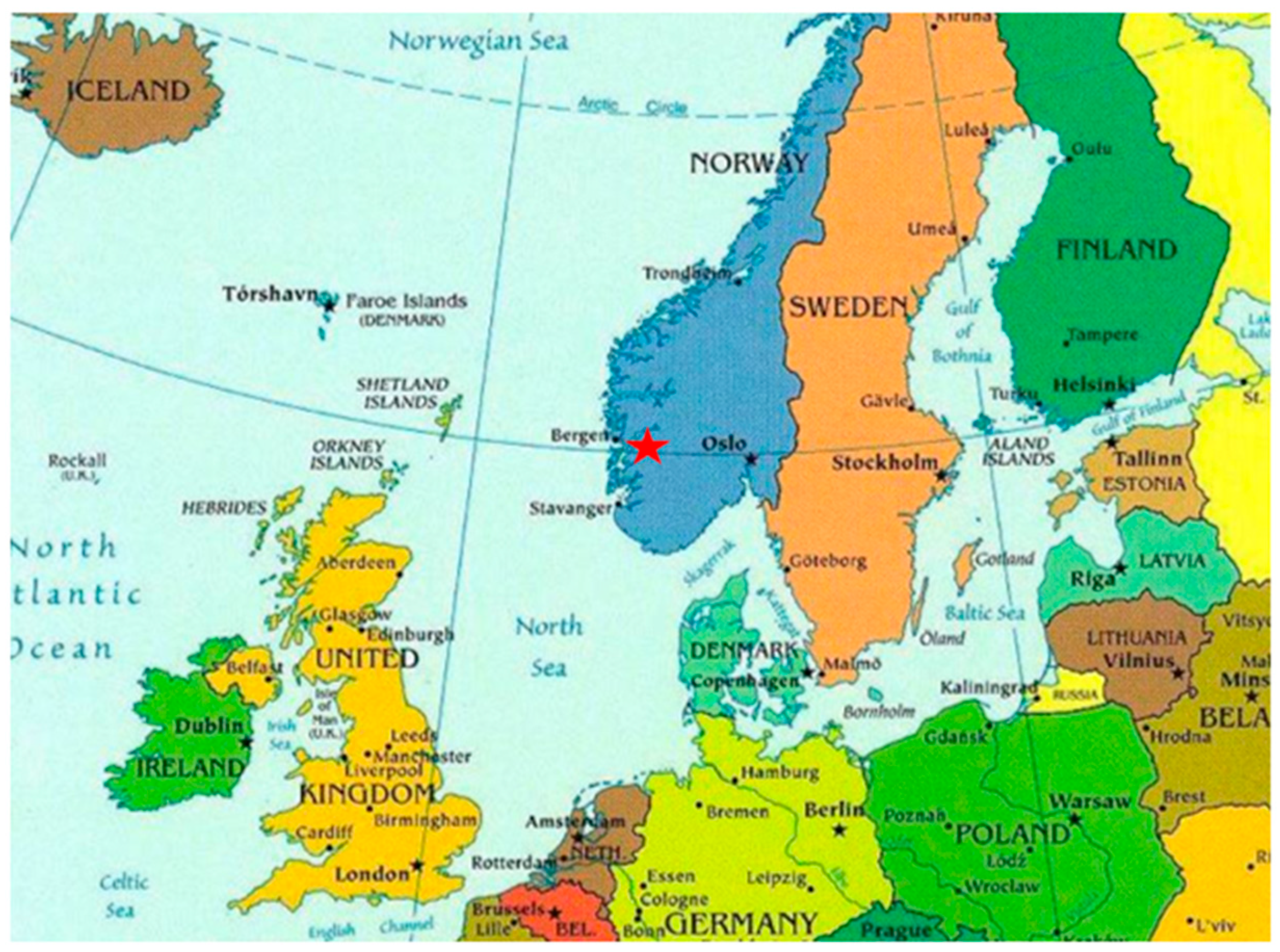

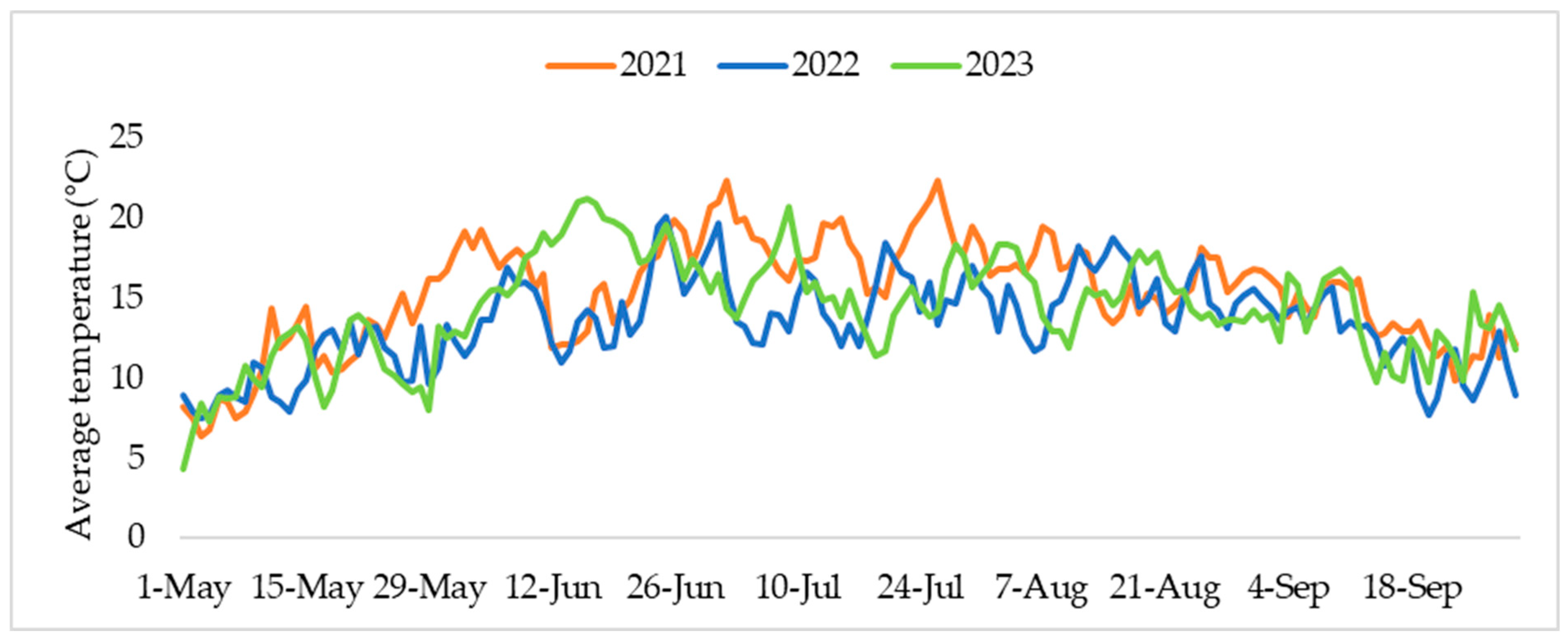
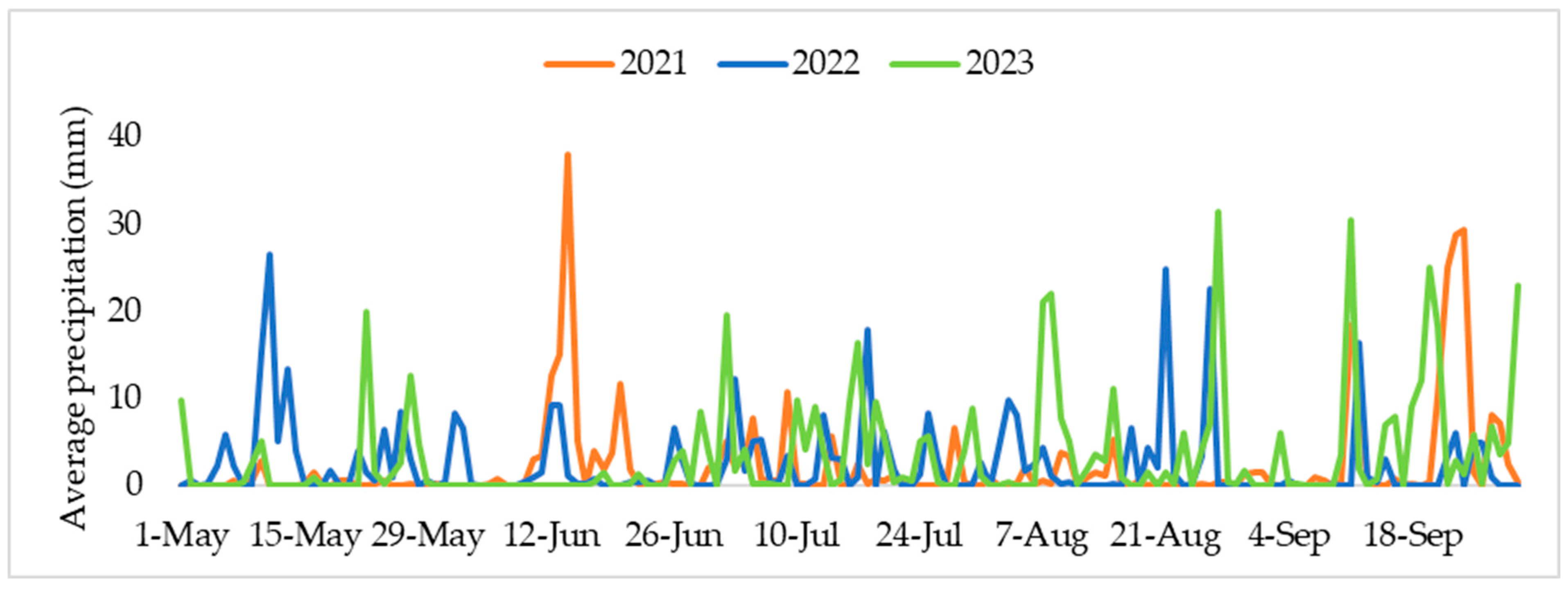
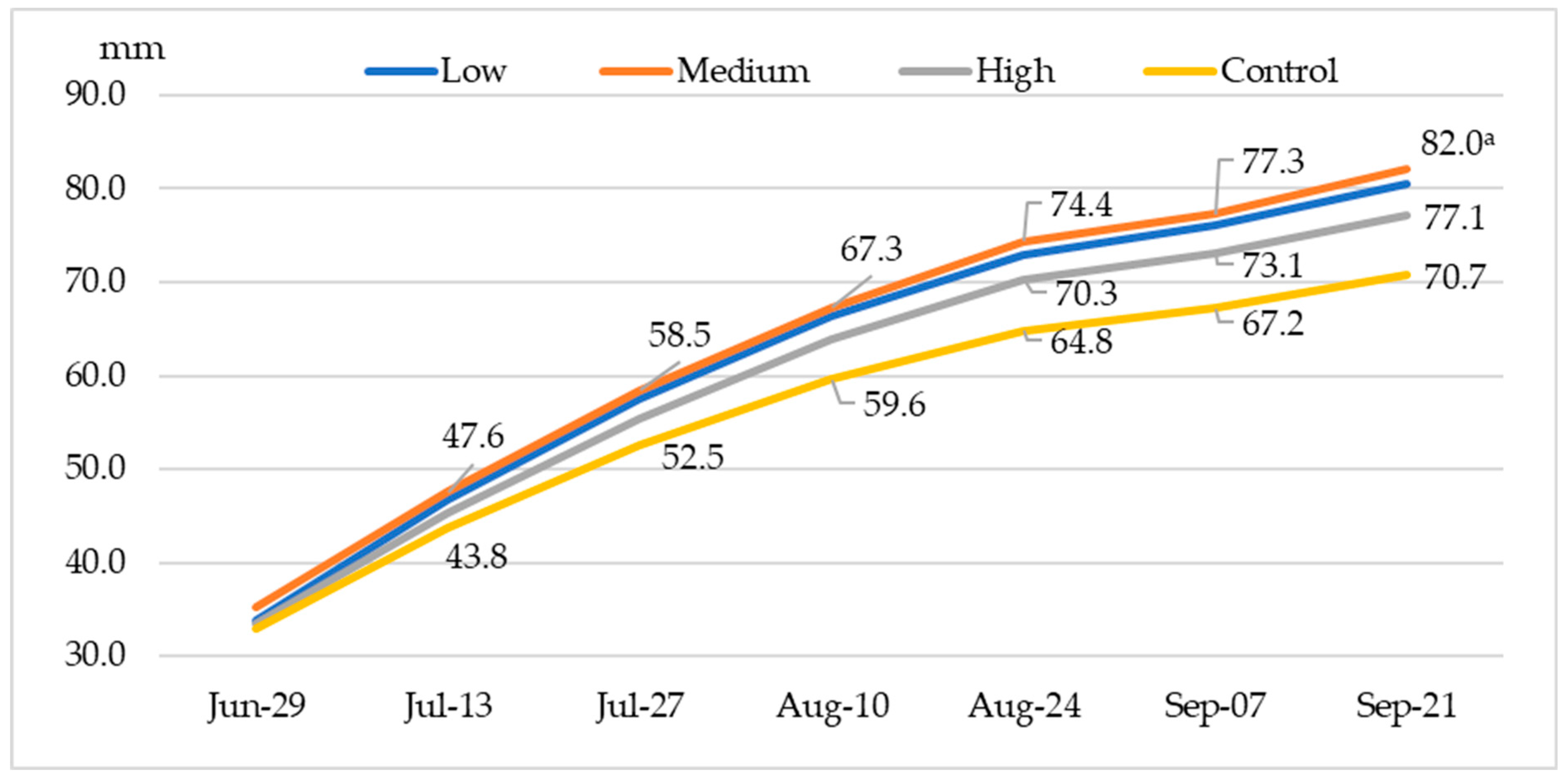
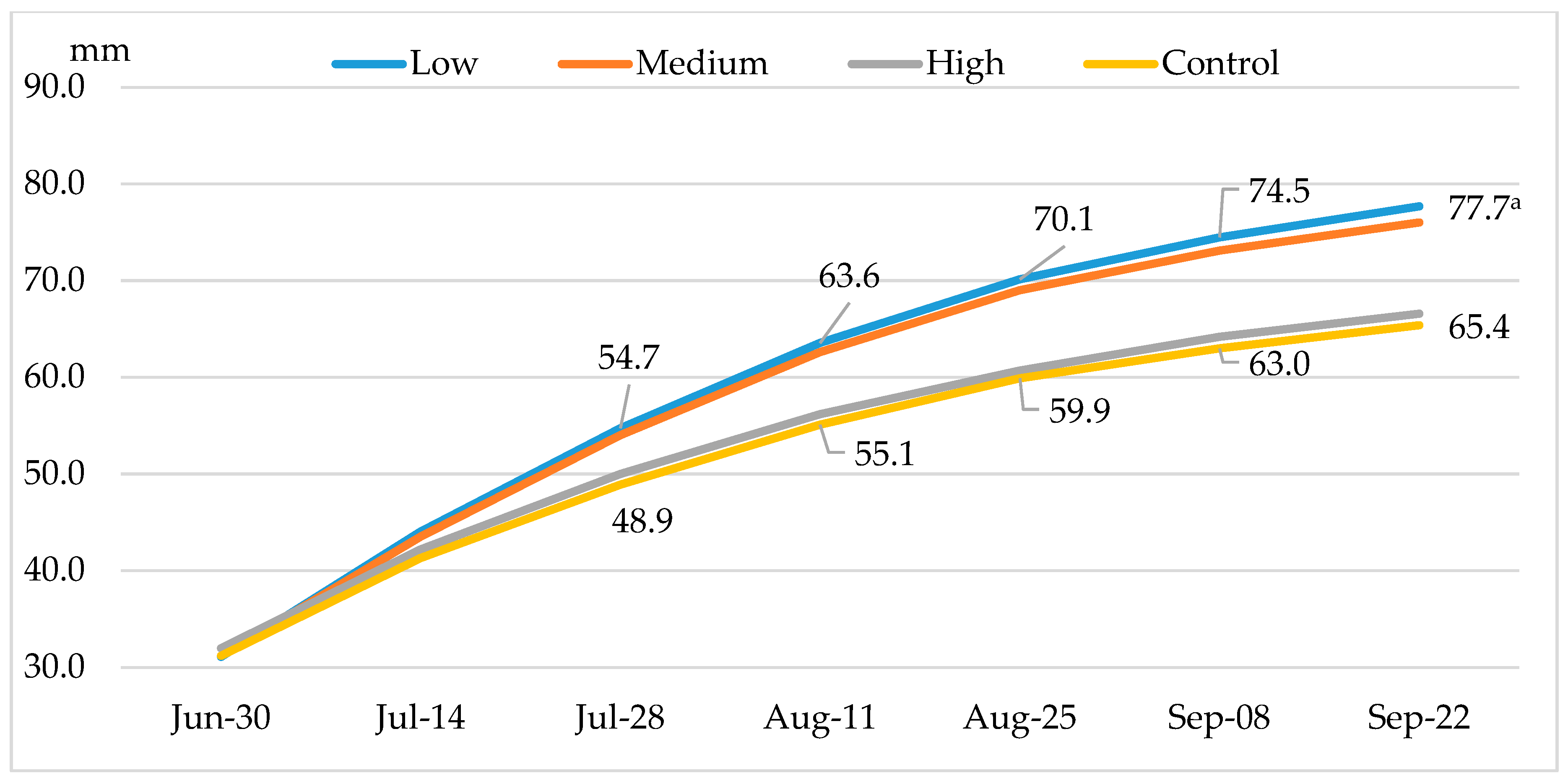

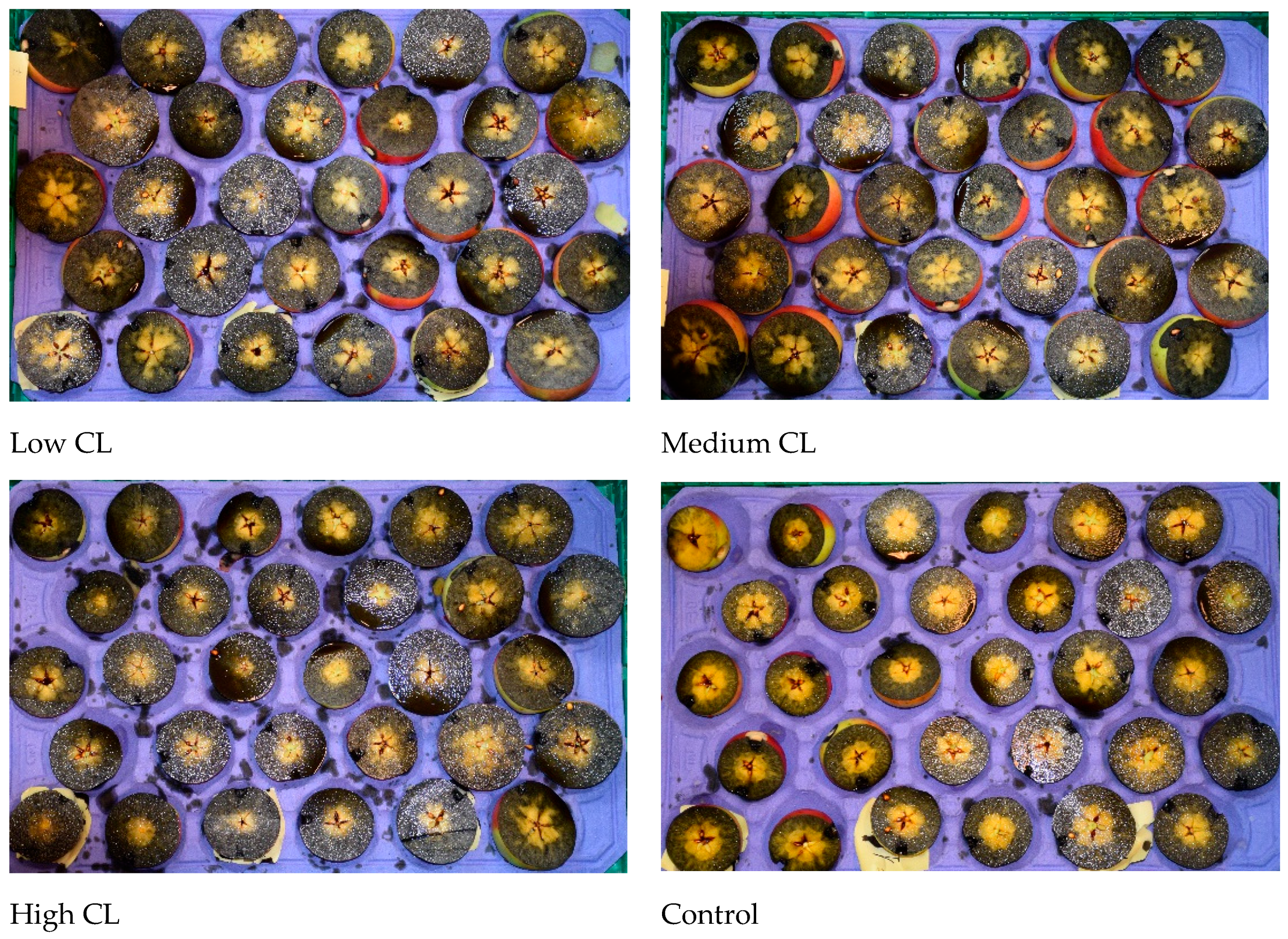
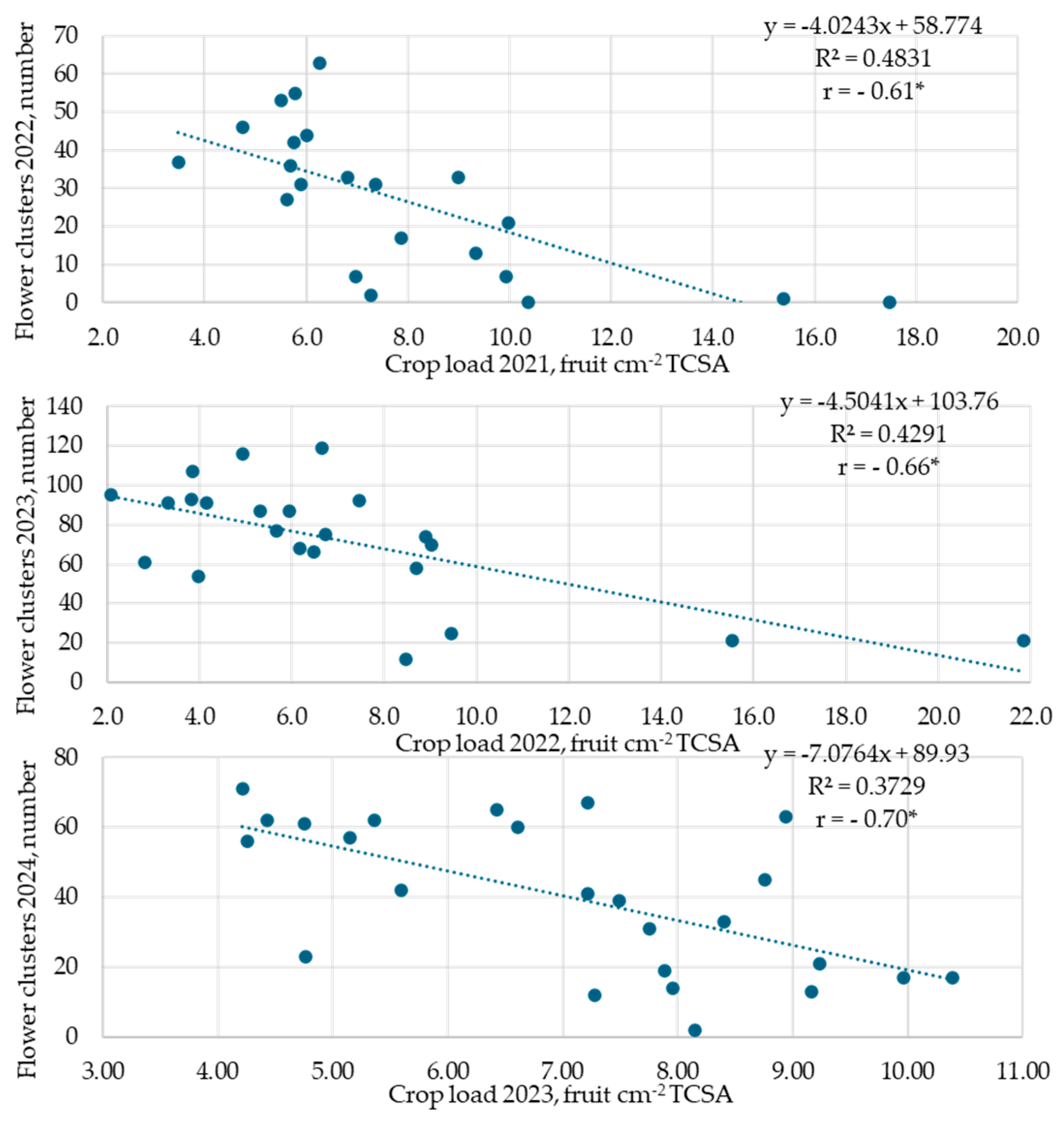
| 2021 | 2022 | 2023 | |
|---|---|---|---|
| Full flowering date | May 19 | May 18 | May 27 |
| Harvest date | September 22 | September 30 | September 26 |
| Crop Load Level | 2021 | 2022 | 2023 |
|---|---|---|---|
| Low | 5.2 ± 0.3 d | 5.4 ± 0.4 c | 9.49 ± 1.4 b |
| Medium | 7.7 ± 0.6 c | 7.2 ± 1.1 b | 10.53 ± 0.9 b |
| High | 9.4 ± 0.4 b | 8.5 ± 0.9 b | 12.38 ± 0.7 a |
| Control | 10.5 ± 0.5 a | 11.6 ± 1.3 a | 12.80 ± 1.1 a |
| Crop Load Level | 2021 | 2022 | 2023 |
|---|---|---|---|
| Low | 229 ± 9.1 a | 191 ± 10.8 a | 217 ± 8.6 a |
| Medium | 223 ± 7.3 ab | 194 ± 9.4 a | 201 ± 7.3 b |
| High | 210 ± 7.9 b | 160 ± 8.6 b | 186 ± 6.2 c |
| Control | 145 ± 6.4 c | 128 ± 7.7 c | 182 ± 7.6 c |
| Crop Load Level | Ground Colour, Scale 1–9 | Blush, Scale 1–9 | Firmness, kg cm−2 | Starch, Scale 1–9 | SSC a, % |
|---|---|---|---|---|---|
| 2021 | |||||
| Low | 5.30 ± 0.41 a | 6.73 ± 0.35 a | 8.15 ± 0.42 a | 1.50 ± 0.21 | 11.7 ± 0.74 |
| Medium | 5.83 ± 0.38 a | 6.73 ± 0.40 a | 7.74 ± 0.54 ab | 1.48 ± 0.19 | 11.5 ± 0.63 |
| High | 5.23 ± 0.35 a | 7.03 ± 0.39 a | 7.85 ± 0.56 ab | 1.40 ± 0.18 | 11.6 ± 0.75 |
| Control | 3.18 ± 0.22 b | 5.20 ± 0.51 b | 6.94 ± 0.61 b | 1.35 ± 0.23 | 10.7 ± 1.11 |
| 2022 | |||||
| Low | 4.03 ± 0.52 | 4.65 ± 0.32 a | 9.50 ± 0.50 a | 1.93 ± 0.22 a | 11.2 ± 1.12 |
| Medium | 3.47 ± 0.35 | 4.17 ± 0.35 ab | 9.34 ± 0.41 a | 2.33 ± 0.26 ab | 11.1 ± 0.85 |
| High | 3.40 ± 0.39 | 4.15 ± 0.41 ab | 9.26 ± 0.38 a | 1.85 ± 0.31 a | 11.0 ± 0.95 |
| Control | 3.40 ± 0.43 | 3.43 ± 0.45 b | 8.11 ± 0.44 b | 2.83 ± 0.41 b | 10.6 ± 1.18 |
| 2023 | |||||
| Low | 4.85 ± 0.23 | 5.38 ± 0.62 | 8.57 ± 0.66 | 3.58 ± 0.39 | 10.63 ± 1.21 |
| Medium | 4.70 ± 0.36 | 5.89 ± 0.51 | 8.55 ± 0.84 | 4.07 ± 0.51 | 10.83 ± 1.33 |
| High | 4.87 ± 0.33 | 6.13 ± 0.64 | 8.11 ± 0.65 | 3.37 ± 0.45 | 10.37 ± 1.20 |
| Control | 4.80 ± 0.42 | 5.10 ± 0.55 | 8.45 ± 1.01 | 3.15 ± 0.52 | 10.60 ± 1.22 |
| Crop Load Level | ||||
|---|---|---|---|---|
| Low | Medium | High | Control | |
| Yield 2021 | 14.81 ± 0.98 da | 22.15 ± 1.23 c | 26.75 ± 1.09 b | 30.00 ± 2.12 a |
| Return bloom 2022 | 42.63 ± 5.32 a | 24.82 ± 1.54 b | 26.24 ± 2.02 b | 6.61 ± 0.55 c |
| Yield 2022 | 15.38 ± 1.59 c | 20.43 ± 2.64 b | 24.19 ± 2.87 b | 33.02 ± 3.32 a |
| Return bloom 2023 | 89.31 ± 7.41 a | 78.26 ± 6.87 a | 62.35 ± 6.22 b | 18.21 ± 4.51 c |
| Yield 2023 | 27.12 ± 1.28 b | 30.14 ± 1.96 b | 35.63 ± 2.74 a | 36.71 ± 3.26 a |
| Return bloom 2024 | 63.4 ± 5.22 a | 66.35 ± 4.51 a | 34.13 ± 3.65 b | 17.34 ± 2.32 c |
Disclaimer/Publisher’s Note: The statements, opinions and data contained in all publications are solely those of the individual author(s) and contributor(s) and not of MDPI and/or the editor(s). MDPI and/or the editor(s) disclaim responsibility for any injury to people or property resulting from any ideas, methods, instructions or products referred to in the content. |
© 2025 by the authors. Licensee MDPI, Basel, Switzerland. This article is an open access article distributed under the terms and conditions of the Creative Commons Attribution (CC BY) license (https://creativecommons.org/licenses/by/4.0/).
Share and Cite
Kviklys, D.; Martinussen, I. Crop Load Affects Yield, Fruit Size, and Return Bloom of the New Apple Cultivar Fryd© (‘Wuranda’). Horticulturae 2025, 11, 597. https://doi.org/10.3390/horticulturae11060597
Kviklys D, Martinussen I. Crop Load Affects Yield, Fruit Size, and Return Bloom of the New Apple Cultivar Fryd© (‘Wuranda’). Horticulturae. 2025; 11(6):597. https://doi.org/10.3390/horticulturae11060597
Chicago/Turabian StyleKviklys, Darius, and Inger Martinussen. 2025. "Crop Load Affects Yield, Fruit Size, and Return Bloom of the New Apple Cultivar Fryd© (‘Wuranda’)" Horticulturae 11, no. 6: 597. https://doi.org/10.3390/horticulturae11060597
APA StyleKviklys, D., & Martinussen, I. (2025). Crop Load Affects Yield, Fruit Size, and Return Bloom of the New Apple Cultivar Fryd© (‘Wuranda’). Horticulturae, 11(6), 597. https://doi.org/10.3390/horticulturae11060597







